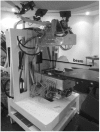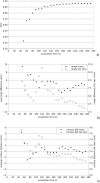Online proton therapy monitoring: clinical test of a Silicon-photodetector-based in-beam PET
- PMID: 29511282
- PMCID: PMC5840345
- DOI: 10.1038/s41598-018-22325-6
Online proton therapy monitoring: clinical test of a Silicon-photodetector-based in-beam PET
Abstract
Particle therapy exploits the energy deposition pattern of hadron beams. The narrow Bragg Peak at the end of range is a major advantage but range uncertainties can cause severe damage and require online verification to maximise the effectiveness in clinics. In-beam Positron Emission Tomography (PET) is a non-invasive, promising in-vivo technique, which consists in the measurement of the β+ activity induced by beam-tissue interactions during treatment, and presents the highest correlation of the measured activity distribution with the deposited dose, since it is not much influenced by biological washout. Here we report the first clinical results obtained with a state-of-the-art in-beam PET scanner, with on-the-fly reconstruction of the activity distribution during irradiation. An automated time-resolved quantitative analysis was tested on a lacrimal gland carcinoma case, monitored during two consecutive treatment sessions. The 3D activity map was reconstructed every 10 s, with an average delay between beam delivery and image availability of about 6 s. The correlation coefficient of 3D activity maps for the two sessions (above 0.9 after 120 s) and the range agreement (within 1 mm) prove the suitability of in-beam PET for online range verification during treatment, a crucial step towards adaptive strategies in particle therapy.
Conflict of interest statement
The authors declare no competing interests.
Figures




References
-
- Parodi K. On- and off-line monitoring of ion beam treatment. Nuclear Instruments and Methods in Physics Research A. 2016;809:113–9. doi: 10.1016/j.nima.2015.06.056. - DOI
Publication types
MeSH terms
LinkOut - more resources
Full Text Sources
Other Literature Sources

